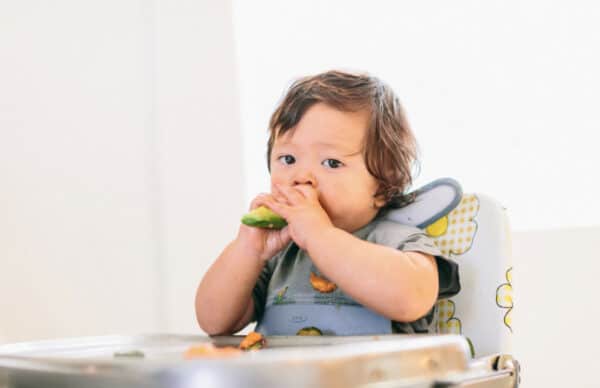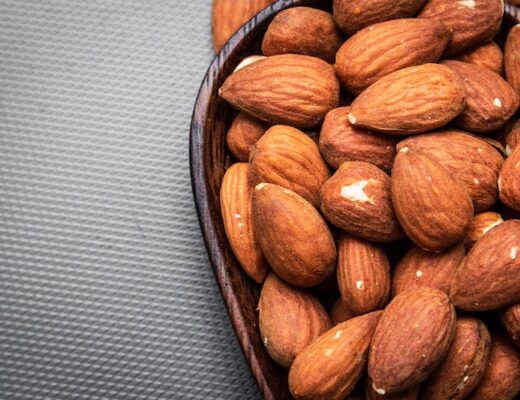
Imagine allowing your baby to feed themselves. No more spoon feeding games or preparing separate meals and mealtimes. The process of baby led weaning includes all of this and more.
In this episode, Timothy and Laura Dahl discuss their experience with ‘Baby Led Weaning’ and share the reasons they chose to begin their children’s adventure with food using this method.
They go over the benefits, the possible pitfalls and share tips on how to get started so your family will succeed.
“Allowing our children to feed themselves is ultimately about respecting them as capable humans with an innate knowledge of the nutrition their unique bodies need.” – Laura Dahl
Eating isn’t something a living being needs to learn. It literally invokes their most basic survival instincts, and they want to do it without choking. As long as a baby can sit up comfortably, they’ll figure out how to get food into their own mouth, safely. They’ll eat until they’ve gotten the nutrition they need from the options presented and they’ll let you know when they are full.

Resources
Bringing up Bebe
One American mother discovers the wisdom of French parenting.
Simple and Safe Baby Led Weaning
How to Introduce Solid Foods and Help Your Baby to Grow Up a Happy and Confident Eater
The difference between choking and gagging
The right size and shape of foods for your baby
Join the Built by Kids Club for activity ideas, DIY projects, and gear reviews.
Please subscribe and share a review wherever you are listening.

Full Podcast Episode
Laura
creative mind for agents for grateful, independent, confident, inspired, empowering our children with the tools they’ll need to create an extraordinary future because it will be built by kids.
Hey, Timothy and Lara doll here from built by kids. Hello, welcome back. Happy to have you here. Today we are diving deep into the idea and the concept of baby led weaning.
Timothy
And this is probably a maybe the first time you’ve heard this term used, but it’s essentially allowing a baby toddler child to feed himself and not going the traditional route of spoon feeding for many years. For reasons which we’ll go over here.
Laura
That’s right. It’s, it’s the technique that we’ve used with both of our boys and it has been a great success for us. And to me to just start it off the the point behind it as a mother, it just feels like the right thing to do. You know, it feels like if you’re spoon feeding someone, it’s because they’re not capable of doing it themselves. It’s because maybe they’re a patient in a hospital or they’re paralyzed or for whatever reason they need extra help getting that food into their mouth, and, or they need help being told what they need to have in their mouth. And baby led weaning says children are capable children are strong children can absolutely get the nutrition they need into their mouth when they need it. And even further, they when give them In great options, great nutritious options on their plate, can listen intuitively to their bodies and choose the exact right food that their body needs at that time, what a freedom what a power to have, rather than the mother or father scooping something that they chose for their child out of a pure a can and putting it into their mouth.
Timothy
Right with a child kind of sitting there passively opening their mouth, or playfully
Laura
opening their mouth. I feel like the images that we see most often is the kid really putting up a fight and trying to get
Timothy
open their mouth and playing an airplane game to get them to, to eat their food, which you know, the struggle of I can’t get my kid to eat stuff and maybe looking at the different way of well, I want to allow your child to eat with They want, and
Laura
as long as you’re providing nutritious options, Yes,
Timothy
right. And so you place these options in front of them. And there are so many, obviously, tasty meals that are helpful and great for them. And, you know, as soon as they can start eating solid foods, they have the dexterity and the full use of their hands and fingers. And they want to have that tactile feel of the different foods and the smells and they can, you know, scoop it from the plate. The one drawback again, it could be a little bit messy because their hands gonna be in it. But you know, it doesn’t work.
Laura
period two, as soon as they learn how you know how to do this and how to get the food from the plate to their mouth. It’s they want that food in their mouth. They’re not trying to turn it into a game. But I think we’ll get into some more details on how actually to begin this process on how to prepare the food. But, you know, again, from a socially social perspective And maybe a selfish perspective even we are a family who that likes to go out to nice meals, we like to travel the world and be able to sit down in Paris for a three hour meal. And we appreciate and value our food, the Grateful for the food that were presented. So we want to raise children who feel the same way who can sit down and have a conversation with their family while enjoying the smells, the fragrances the textures, of real food.
Timothy
And I think that was a big impetus for us that this the amazing book bringing up baby explains in so many more details that concept and why French kids can go to a restaurant and eat fancy quote unquote food from an American’s perspective and be happy with it. So that’s where we wanted to go with it. They really I’m I mean, we can go through the benefits here, but one of the big ones is they eat what you eat. So as you’re cooking your meals, you know, you’re you’re setting aside maybe something that’s maybe not as, as spicy, but otherwise, they’re eating what you eat, we’re all sitting around the table eating at the same time. And you’re not, you know, putting together a separate meal that, that, that they have, that they see you eating something else, and they want that. So everybody’s all in together, we’re sharing and they’re just immediately, you know, part of the family and so when you, when you take this from the home, you take this to a restaurant, it’s this, it’s this, you know, the same concept. It’s not like you have to break out, always something new and different for them. So, so eating together is a big thing. And it also frees up you know, the parents to, to be eating with their child not just feeding and then you feed yourself. So when you said maybe, selfishly, but it’s, it’s something that, you know, it balances out, you know, for the whole family to be enjoying mealtimes together.
Laura
Absolutely right. I consider elfish a positive thing in that in that regard because we don’t want to be making an extra meal we don’t want to be battling our child at a restaurant and so selfishly we want them to be able to eat their own foods and that’s how we do how we make a lot of choices in our lives and in our parenting.
Timothy
So tell me, how would How did we and would you recommend people introducing this to their baby or toddler who is soon to be eating solid food?
Laura
All right, we started both our boys off with avocado is the first food and that’s such an easy one. You know, you can you just slice it right up, you can keep the skin on it, in fact, because there’s not likely that any human is going to want to actually master ate a skin of an avocado and so they want in and digest that and ingest that. But it does give them something to hold on to it’s not too slippery and they You can just kind of know right on right off of it. Avocados has so many nutritious benefits that is for another podcast but that’s, that’s one of our very first ones we also love sweet potatoes and cutting them up in, you know, large I mean would you wouldn’t say maybe an inch by four inch kind of slices. We found our boys could easily pick up from their tray and go to town on. cucumbers are another great option. melons. I mean truly, if you can think of any whole food that is coming as directly from the earth as possible. You can turn it into an amazing baby led weaning food,
Timothy
right fruits and vegetables all pretty much follow follow right into that and if this is their first food and all the tastes and textures that they’re getting, it’s the best way to get started in though pretty much always consistently, you know, enjoy eating those types of foods. So you’re not struggling with something that introducing something that was really unnaturally sweet in the beginning and kind of, you know, kind of changing their palate.
Laura
That is such a good point, Timothy, right. I mean, this is the great opportunity to introduce those foods that you might even think are a little funky or not your favorites. Give it to them as a child, as a baby, allow them to enjoy that experience and become used to that nutritious food so that when they’re adults, they do love it.
Timothy
And, you know, bananas, apples, berries, those are so naturally sweet, right? And we, as adults might be stunted to how sweet they are, because we eat candy and other sorts of things. But for a baby that’s just like candy for them. So if you think of it that way, it’s there’s plenty of delicious sweetness for them yet
Laura
being mindful of you know, not To create an overly sweet palette for any of our children, so they’re not craving, you know, white processed sugars as they grow older.
Timothy
And going back to the main point here with the child feeding themselves, they will you put this out in front of them and when they’re done, they’re done. They let you know, we’re not having to set a set amount of how many ounces they need to get what you know, that you feel like they need to be healthy to, to be growing at a certain rate and all of those sorts of things. No, they’ll eat, you know, as long as everything’s, you know, helpful out there, they’ll they’ll keep eating until they’re done. And when they’re done, they’ll let you know.
Laura
And that might be one of the most challenging parts of this for so many parents because it requires faith in instincts. It requires faith in knowing the way our bodies work. And again, knowing that our child will eat those foods that have the minerals and vitamins that they need at that time and they’ll eat just the right amount of it. We don’t need to be looking at charts and growth charts. And as Timothy says, measuring every ounce of everything because you have you allow yourself to have faith in your, in your baby’s knowledge.
Timothy
Right, they, they know so much more obviously, as we all know, then then we realize and then, you know, again, allowing them to to make these choices just provides them, I got to believe a sense of confidence, hmm. And it’s just the incremental you know, these incremental choices, these incremental choices they’re making through eating to whatever is just got to, to build up in them got
Laura
the confidence and independence from the get go with something as wonderful and necessary as food. What a power.
Timothy
Right. Don’t want to gloss over though some of the challenges,
Timothy
it’s different because Well, for one thing, our kids start out from the beginning. I think we’d go back to a story where with hunter our first child we thought hey, this is what you do you get a little spoon out and you feed them and I think Laurie you can you can kind of stay Wow, this felt and when we first tried this what happened,
Laura
right I did kind of mentioned at the beginning, but it did it just felt like I was feeding someone who wasn’t capable. Someone who wasn’t in control of their own body was someone who needed me to do this for him. And every instinct in my body said, No, he’s, he’s a human. He’s a fully functioning human. He’s just has a lot to learn. And I didn’t want to be. I didn’t want to be treating my son as though he were an invalid in a hospital. I wanted to treat him as a fully functioning, confident, independent human.
Timothy
Right. And because we look at that approach with everything that he does, and allowing him to take, take control and a sense of, of these within kind of parameters we sweat set. But eating and feeding himself was a big part of that. So I think for both of us, once we released the thoughts of the traditional way of how we do things, then it all just made sense. And from that day forward, we just placed the plate of food in front of him and he just went to town on it. And that’s just the way it was. And so it was a natural way to do that with our second child and I can see so going into some even challenge if you had already done it one way. Then how do you go back? How do you kind of introduce this
Laura
perspective, right because
Timothy
I don’t have experience with that. But I can see recently we were with with a child who or kind of baby who was eating solid foods. And, you know, you put, I think we both felt that as food was being delivered into his mouth by a spoon being spoon fed. Um, you know, she had her hands out. And she was looking to kind of maybe get more involved herself.
Laura
The child Right, well, and it was a great opportunity because the mother needed to leave the room and left the child with us. And I just put a Clementine in front of the baby and she picked it up and devoured it. And yes, her hands got a little sticky. And yes, the juices were drizzling down her neck and shirt. But guess what she was loving that Clementine that she had rejected moments before when it was being placed into her mouth. So I mean, what it what an incredible experiment that is.
Timothy
Yeah. So I could say, if there’s something even thinking about just go for it. Right. And there are resources that are online and that we use finding our site as well, that, you know, get go, you know, deeper into some of these different baby led weaning foods such as avocados and things.
Laura
We’ll put out our own, you know, recipe book, which is very simple as you can imagine hearing what we just said all about it, but just to give you some ideas and a good, you know, jumping off start point,
Timothy
you know, another challenge that or fear that, you know, I definitely initially had was the thought of a child choke and
Unknown Speaker
so I was just gonna say it right. And
Timothy
you know, and we’re not doctors and are experts in how that works out. And I think again, that’s our biggest fear of seeing a child’s like, you know, stuffing something in their mouth or no food or whatever it is, and then not breathing. So
Laura
and interestingly, our first son never once had an issue with choking our second son, there were at least three or four times I can remember sitting at the table, and Timothy and I both losing our breath, a hunter included as we’re watching him You know, work this out. And I think that he survived though,
Timothy
again, we did quite a bit of research before we even kind of went down this path. And from what I recall, and what’s kind of played out here is that a child’s say gag reflex
Laura
is kind of a normal reflex that we all have. That just kind of engages and it’s stronger for babies in fact, so where it might take food to go all the way back into our throat to gag where it could actually get lodged in our throat. A baby’s gag reflex will come up much much closer to the bit wet the the front of his mouth,
Timothy
right and so again, we’re not you know, no experts here but from our observation what’s worked for us we really don’t see you know, our second sign actually, you know, he eats a lot more and he stuffs rice right right. So he might be putting a lot more avocado in his mouth right before he can before can swallow it. But you know, I we do recognize that’s a that’s a concern, but You know, with the right amounts, and you know, obviously, cutting things in, in the right is
Laura
vast mind. And actually let me step in there because most parents, so you’d think maybe instinctively that you should be cutting this very small so that they can easily masturbated and swallow it. But in fact, the opposite is true, the bigger the piece, you know, within reason for their little hands, but the bigger the piece of that meat, they can just knock on it. For instance, if it’s, you know, a big carrot that, of course, is steamed, they can just knock on it, whereas if it were smaller, much easier for that to get lodged in the back of their throat, right? So larger is better, in fact, with baby led weaning,
Timothy
right, I think, yeah, it’s all again, going by instinct, and seeing how you feel and how comfortable you are with with all of it. So if it’s, again if you want to introduce it more slowly and, and see But again, I think one We don’t want to see a child kind of take to it. They just want to go, it’s liberating. It’s so exciting. And it Timothy mentioned the mess it, it can be a mess at the beginning, but just like potty training potty learning, that’s also a mess at the beginning, but guess what you get through that little phase and you are golden, the rest of your life. And your son, he’s he’s been using utensils right now at an early age. And he’s I mean, he’s been using utensils probably the last year almost. Yes. And he’s almost two years, almost two. And so that part of it using the tools and you know, even you know, I’ve sometimes I’m amazed that he’s, you know, how he’s able to articulate this, these spoons and forks and how he wants to, because he wants to emulate what we’re doing right. And that itself is also you know, leads to being cleaner and you know, him just again, I think obviously, tools are a big part of, of different things we talked about here but using tools such as you pencils, at one years old is still fun. It’s
Laura
very fun and just talking about different ways that baby led weaning can just help enhance the entire brain, the entire the entire growth of the brain. You know, he’s looking at different shapes of food at different colors of food. He’s feeling different textures of food. I mean, what better thing people go out and spend a bunch of money on different blocks that can provide the same experience that you can provide on your table at dinnertime.
Timothy
Any other follow ups with with this? I think we could, you know, we can talk about a lot of thing now. if people have questions. Yeah. You know, to us again, you know, just doing
Laura
a lot of research on there.
Timothy
Yes, there are and I feel like a lot of them come from Europe. Is that where the new This is more more common.
Laura
I brought it up. Yeah, I brought up that book bringing a baby which was one that really kind of opened my eyes to it, but way we’ll you know provide a lot of resources here in the in the show notes for all of that because, as you can tell, we are proponents of this. It’s worked so well for us. It’s helped us raise some incredible independent healthy boys.
And we want the same for you.
Timothy
Bon appetit!



